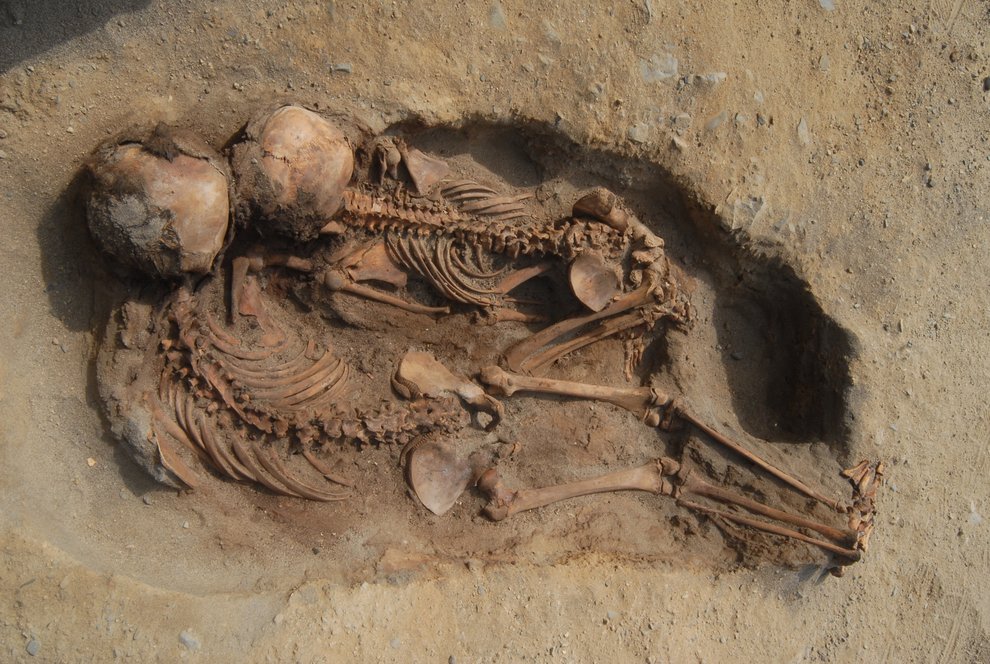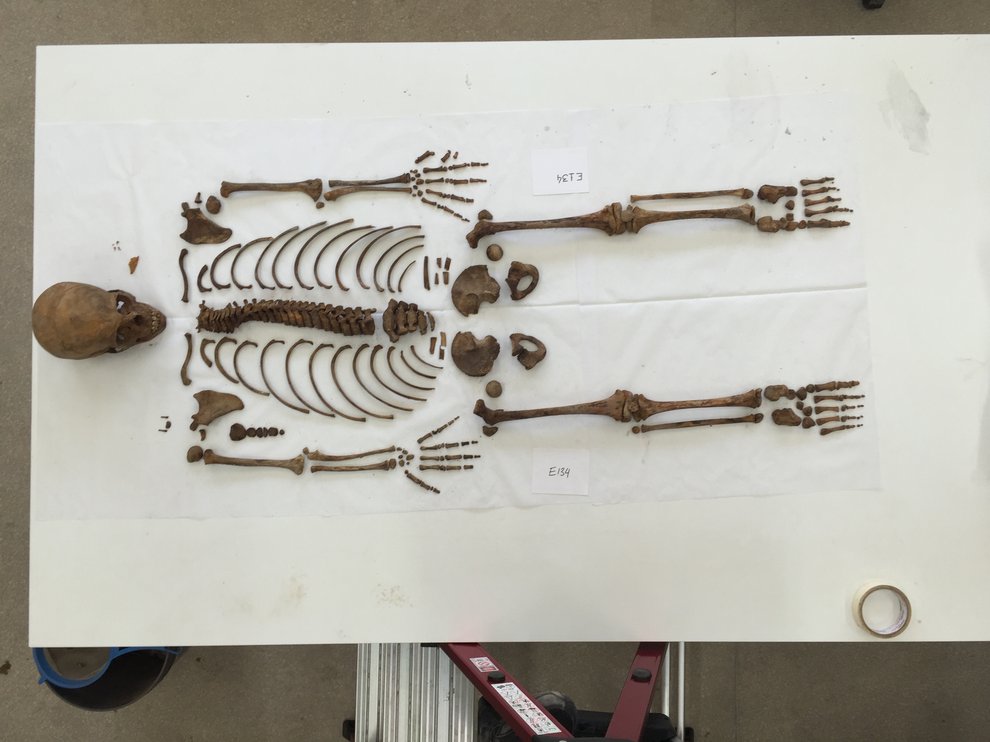What Prompted the Mass Sacrifice of Hundreds of Children and Llamas in Ancient Peru?
Archaeologists think the ritual, which felled 137 children and 200 llamas, might have been motivated by recent natural disaster.

The Peruvian archaeologist had been midway through a dig on the outskirts of his hometown of Huanchaco when a local business owner contacted him with alarming news: His two children had trudged home from a long day of play carrying a cache of what looked like human bones.
Prieto dropped everything. Shortly after seeking permission from Peru’s Ministry of Culture to conduct an emergency excavation, he and his team began to dig. “From the very beginning, I realized this was something big,” Prieto says.
He was right to follow his hunch. Within hours of breaking ground, the researchers had uncovered the skeletal remains of dozens of bodies dating back some 550 years—evidence of what would become known as one of the largest mass child sacrifices unearthed in history.
Eight years later, Prieto and his colleagues chronicle their years-long excavation in a study published today in the journal PLOS ONE. According to the researchers, around 140 children and 200 young llamas were among those sacrificed around 1450 CE, near the capital of what was then Peru’s Chimú Empire. Though the motivations behind the ritual remain mysterious, it’s possible the massacre occurred in response to a destructive bout of heavy rainfall and coastal flooding.
“This is unprecedented,” says Sara Juengst, a bioarchaeologist at the University of North Carolina at Charlotte who was not involved in the study. “I’ve been working in South America for 10 years, and I have never heard of anything like this before.”
The sacrificial site, known as Huanchaquito-Las Llamas, dates back to the later years of the Chimú Empire, Peru’s most prominent pre-Incan civilization. Today, Las Llamas is located on the outskirts of the city of Trujillo, home to nearly 2 million people. In recent years, Trujillo’s rapid urban expansion has encroached on several archaeological sites, inadvertently revealing occasionally gruesome artifacts.
Such was the case with Las Llamas when, in 2022, the now infamous collection of human and animal bones began to erode out of a roadside dune. It didn’t take long for the site and its artifacts to draw the attention of an international group of researchers, including John Verano, a biological anthropologist at Tulane University. “I’ve worked in this area for 33 years, but we really had no idea that anything at this scale had ever happened,” Verano says. “Globally, there is nothing comparable. It’s a pretty dramatic and unexpected discovery.”

The brutal final tally yielded the remains of at least 137 children, 3 adults, and 200 young llamas. Early on in the excavation, consistent motifs among the dead indicated that the researchers had stumbled upon a sacrificial event, rather than a typical burial ground.
Among the children, boys and girls alike were selected for the ritual, and appeared to encompass several different ethnic groups within the Chimú Empire which, at its peak, held dominion over a 600-mile-long territory from just south of Ecuador down to central Peru. All the children appeared healthy at time of death, with most in the range of eight to 12 years old, though several might have been as young as five or as old as 14.
These stunning numbers highlight a purposeful cultivation of youth for a clear sacrificial event, says Tiffiny Tung, a bioarchaeologist at Vanderbilt University who was not involved in the study. “This was not a weird demographic blip,” she says. “There was a very clear, conscious decision that this ritual had to be enacted through the bodies of children.”
Among the Chimú, children were likely considered transitional beings, hovering between human and godlike, celestial and earthly. On the cusp of adulthood, their bodies were more androgynous, their societal roles not yet crystallized. Lost to sacrifice, those futures would never come to be, Prieto says. This could have been the Chimú peoples’ way of offering up the most precious thing they could conceive of.
In light of this, the llamas might seem an afterthought. But as a source of food, transportation, and fiber for textiles, these animals represented a valuable commodity in pre-Hispanic Peru. Such a culling would have amounted to significant economic loss for the ancient Chimú, Verano says.
Bolstering the case for sacrifice, close examination of the remains revealed that the children and llamas were probably killed by expert hands. Many of the bodies showed the same patterns of damage to the breast bones and ribs, hinting that their chests had been sliced open and pulled apart so their hearts could be removed, perhaps for a separate rite.
No written records from Chimú society survive, so the significance of the heart, like much else, remains an open question. But Verano has theories. “The heart beats—it’s the thing we can feel in our chests,” he says. “That’s a very dramatic thing, and many ancient societies considered it an important organ. It may have been something seen as related to life and strength.”
The victims’ bodies were then placed in what seem to be purposeful arrays, with most of the children interred facing the sea to the northwest and the llamas looking to the Andes in the east. Whatever symbolism underlies this sacrificial choreography isn’t entirely clear, but the consistency of the arrangement indicates it had some significance.
“This is a phenomenal contribution to our understanding of ritual practices in the Andes,” Tung says. “These were not isolated one-offs. This was a very premeditated, sanctified, ritually codified practice.”
The three adults—two women and a man—pose more of a puzzle, however. While their chests weren’t opened, all three were buried close to the children and llamas, and appear to have been part of the ritual. Prieto thinks that the women might have been caretakers for the children during the extended congregation that likely preceded such a large, coordinated ritual. The man, on the other hand, might have been the executioner himself.

lso unveiled during the excavation was a series of footprints preserved in a layer of dried mud. The imprints paint a grim portrait of barefooted children, sandaled adults, and leashed llamas, all hailing from different locales, but converging on a single sacrificial site—a macabre, unifying march to the death.
In this soil might also lie some of the only clues about the motivations behind this grisly assembly. Under normal conditions, the landscape of Las Llamas featured a series of sandy dunes. But at the time of the sacrifice, the area had recently been blanketed by a thick, impressionable layer of heavy mud, clay, and gravel, possibly due to a recent climate event related to El Niño.
Uncharacteristically warm ocean waters might have taken their toll on marine food sources, while the torrential downpour and flooding could have ravaged the Chimú peoples’ extensive infrastructure of agricultural canals. In light of such devastation, the sacrifice might have been a desperate attempt to quell the onslaught.
It’s hard to know for sure if natural disaster was truly enough to prompt such a strong reaction, Verano says, but it wouldn’t be the first time two such events were linked. For leaders who ruled under the guise of near-omnipotence, inclement weather could give the impression that they’d lost their edge, he explains.
Others, however, have noted that the sacrifice occurred somewhat close to the cataclysmic conquest of the Chimú by the Inca around 1470 CE. Verano has “a hard time making a logical sense out of killing your children to stop a military conquest,” but it’s still possible the urgency of both situations built off each other.
Either way, the sacrifice might have served several purposes—an effort to appease the gods, perhaps, or a timely display of power. “This tells us about the authority of the Chimú state,” Tung says. “A ritual like this sends a strong message. It’s a way to subjugate and create social control [amongst your own people] without even touching the flesh of others.”

Going forward, this excavation might not be unique: The researchers are already hard at work at another site nearby, where the numbers are so far looking similarly staggering. But the final chapter on Las Llamas itself has yet to be written. The researchers are still conducting additional testing on these remains, including more in-depth DNA analysis that might help determine if any of the victims were related to each other.
In the meantime, the researchers stress that they don’t want these findings to be taken the wrong way. Dark though this display was, there was probably an element of honor in participating in the sacrifice, Juengst says. “It may be something that’s hard for us to conceive of, but the belief may have been that this would help society in some way,” she says. “It wasn’t necessarily malevolent or violent. And unless we’re within that cultural context, it’s hard to judge.”
And while child sacrifice is a taboo topic in the modern world, it’s important not to deny the reality of a culture’s past, says Vera Tiesler, a bioarchaeologist at the University of California Institute for Mexico and the United States who was not involved in the study. “We shouldn’t deny these societies their real history,” she says. “We need to comprehend it in an objective way—interpret the evidence, understand it, and go as deeply as we can.”
